
The George Inn.The Street.

Charmouth is very fortunate in having today one of the oldest continuously run Inns in the country. As with the many buildings in the village that I have researched over the years for Shoreline it has a remarkable history stretching back to the Middle Ages when the village was owned by the monks of Forde Abbey.
Its name is a clue to its origins for an even older Inn at Norton St. Phillips in Somerset, bears the same name dating back to the 14th century. Our Inn may well be a contemporary as in 1295 the Abbot created a borough here and The Street was divided into half acre plots stretching back on both sides. The ancient north wall still stands today with many of the boundary walls of the plots surviving. This had been the case with The George and the 1841 Tithe map reveals a plot slightly over a half acre. The name given to the Inn is again very historic and derives from our patron saint St. George and not the later Kings of England. I am quite confident that it was originally a guest house or Inn at the side of an ancient roman road that linked Dorchester and Exeter where travellers would receive hospitality. It was listed of historical interest in 1952 after being thoroughly surveyed as follows:
Hotel, formerly coaching inn. C17, C18 and later, with C16 roof-core. Stone walls, rendered, Slate roof with gable ends. 4 stacks; 3 of brick, one rendered. 2 on ridge: at left hand gable and towards right hand end;2 near front wall eaves. 2 storeys. 6 windows: 2 are stone mullioned (left hand ground, and first) of 4 lights with ovolo-moulds. Rest are wooden sashes with glazing bars, 2 tripartite towards right hand end. Projecting porch and canted bay window over in bay 2. Wooden porch with lateral benches, weather-boarded bay with sashes, pyramidal slate roof over. Entrance to former coaching yard at right hand end. Interior: ground left: open fireplace with straight-chamfered stone jambs
with straight-chamfered wooden lintel over. C17 or earlier. Mid-chamfered beams with tongue stops. Upstairs: similar, mid-chamfered beams. Accommodation in small rooms off the back wall corridor. Low small doors, probably C18 conversion. Former cruck construction visible (2 trusses), probably C16.
Their dating of the building based on the roof timbers as 16th century (1500-1600) would confirm its ownership and construction by the monks. It was their last Abbott, Thomas Charde who spent considerable money on remodelling Forde Abbey and Charmouth. It was his brother, who was Steward at that time and he lived in the Abbotts House opposite which still bears the initials T.C. above its doorway. The fine building that was to be The George, may well have replaced an earlier one on the site dating back to the founding of the borough in 1295.
It was to remain in the ownership of the Abbott until the dissolution of Forde in 1539 under the instructions of King Henry VIII. The sequestration was carried out by Sir William Petre who was to ultimately own the village. In 1564 he carried out a thorough survey of his purchase, which can still be seen today in Devon Record Office. It lists all the tenants and provides some descriptions of the properties. The most interesting is that of the Stewards house as being the “fairest house in the town and builded by the last abbot of Forde “. This was later to be known as “The Queens Armes”, but today as “The Abbots House”. It is difficult to pin point “The George Inn” precisely. Although I feel confident that it was leased by a member of the Limbry family who were prominent at that time and appear on the early records of “The Fountain Inn”, the other hostelry at the top of the village.
I have been very fortunate to locate in the Wiltshire Record Office a magnificent indenture relating to the George Inn dating back to 1704. For some reason it was lodged there by Ushers, a brewery who later owned the property. It is not often that you can go back that far so precisely, and it was to be a catalyst to its earlier history. For it records that in that year it was in the tenure of Richard Darke, but a Robert Shute had previously been the tenant. I was to find that over the centuries there were two paths to track down - that of the owner and that of the tenant as it was rare for someone to be both. The ownership was usually a wealthy family or brewery. The further you go back in time the more difficult it is to locate records, and this was the case with Robert Shute. It did help in the belief that the Limbry family owned it as there was a Court case in 1682 where there is a reference to a meeting at “Mr. Robert Shute`s House being the signe of the Fountaine in Charmouth”. The parish records are helpful in that they show that he and his wife were to have three children baptised in the Church - Benjamin (1665), Joseph (1665) and Martha (1667). This would take his time as landlord of the George to the mid-17th century and he may well have been there on the historic night in September 1651 when King Charles II stayed for one night at “The Queens Armes” opposite on his abortive attempt to leave these shores for France. It is astonishing to think that the village may well have had four hostelries at this time with the Queens Armes, Rose and Crown and Fountain Inn as well as the George. It’s position on the main coaching road between Dorchester and Exeter would explain why there were so many Inns. The early document from 1702 records that the next tenant after Shute was Richard Darke. Again, the only clues we have to this gentleman’s time in Charmouth is in the Parish Records. He married Sarah Sanger in Charmouth in 1705 and they were to have two sons - Edward in 1706 and Richard the following year, who was to later marry Mary Massey in 1726. In the Dorset Record Office at Dorchester is an incomplete series of Ale House Returns for the county which are very useful in tracking down landlords of Inns over the years. It does show Richard Darke as the landlord of the Ship Inn (Coach and Horses) in 1714 and records James Dober at the George Inn. It is this gentleman who pays £60 in 1702 to John Burridge for a 1000-year lease and a rent of “one Penny at the feast of St. Michael The Archangel, only if the same lawfully demanded.”
John Burridge (1651-1733) who had previously owned the George Inn was a member of the famous family of Merchants who lived in Lyme Regis. Their fortunes had been made as owners of ships trading goods around the world. They are more infamously remembered today though as slave traders making the vast journeys across the Atlantic from Africa to the West Indies. John and his brother Robert Burridge bought considerable properties with their wealth including Hogchester Farm near Charmouth and the Fountain Inn (now Charmouth House). John had been Mayor of Lyme Regis three times and their member of parliament in 1689-1695 and 1701-1710. In 1702 he found himself in financial difficulties and had to sell a number of properties including The George. By 1710 his position had improved and his nephew, John Burridge took over his seat in Parliament. He died in 1733 aged 82 and is buried in Lyme parish church which has a large memorial stone to him in their entrance today. In his Will he left most of his property, including The Fountain Inn to his brother Robert and nephew, John.
James Dober is recorded in the 1702 Indenture as coming originally from Stratton and lately from Dorchester. The parish records reveal that he was married to Jane and they had two children - Frances in 1705 and James in 1708. His name appears on the 1714 Ale House Lists for Dorset and again in 1723 with John Goreing for the Fountain Inn and Richard Darke for the Ship Inn (Coach and Horses). On his death in 1725 he was buried in Charmouth Parish Church and his Will preserved on the Dorset Record Office describes him as an Inn-holder. The witnesses to this were Samuel Symes and George Browne, who had previously acted as a guarantor on the Ale House lists and was a Brewer whose business was ultimately bought by Palmers.
James Dober left his Inn to his wife and son, James, who sold it to William Raymond whose name appears on the Ale house list for 1730. The parish records show that he and his wife Elizabeth had a daughter, Elizabeth in 1730 and a son, William in 1733. His life was cut short when his burial is recorded in 1735. The George was then bought by the village blacksmith, Samuel Burrow, who lived and worked from a house where 1-3 Hillside were later built. It was described as that “Messuage, Tenement or Inn called or commonly known by the name of the George Inn and the curtilage, backside, garden and orchard to the same”. He went on to purchase other properties in Charmouth including the Elms, The Rose and Crown and Langmoor. Unfortunately, he was to get into financial difficulties and by 1743 had to mortgage them to the wealthy Walter Oke, who lived at Axmouth. The Poor Rates for 1754 detail Samuel Burrows as owner of “The George” with his other purchases. Eventually, the loan was foreclosed, and Walter Oke became the new owner of the George Inn and the other properties in 1757. He was to die just 3 years later, and his wife Frances inherited his large estate. Her name appears on the Land Tax and Poor Rate lists that have survived for the village as owner of the George until 1793 when it is bought by Thomas Morgan. There was a survey of the village in 1783, produced for the Lord of the Manor, Francis Phipps Henvill by James Upjohn. The map that went with it has sadly been lost, but its record book was copied by the famous historian, Reginald Pavey and describes the George as being owned by Frances Oke and containing 2 roods 4 perches, just over half an acre, the size of the original burgage plot dating back to the 14th century. The Land Tax provides some information about her tenants for in 1761, John Diment was renting it and in 1787, Samuel Gosling was paying £1-3-9d on it. The Poor Rates lists describe it as an Inn rated at 4s with a house in the garden at 9d.
Thomas Morgan with his wife, Mary had four children, Thomas, George, John and Sarah. His wife died in 1805 and he passed on soon after in the following year. His will records that he left just £200 to be divided between his children and two grandchildren, Thomas and Charles. His daughter, Sarah, born in 1770 had married Richard Hawkins and it is he who is shown as the Landlord at the George Inn on the death of his father in law. The Rate books reveal that the Inn and orchard were valued at 4s and the house in the garden at 9d which was let to Charles Gale. I could find little in the Parish Records about the Hawkins apart from the fact that they had a daughter Mary Eliza Hawkins who in 1818 married John Love who was aged 21 in Charmouth. There is another record that has survived which shows that in the year 1821 he was applying for a license for The George and again the Bridport Brewer, George Browne was acting as Surety. He died the following year and it was his son in law, John Love, aged 25 who took over the George Inn. He was a butcher who lived and ran his business from a building that disappeared in 1861, when it was bought by trustees of the church and demolished to widen the Churchyard at the front. There was a pound next to it where cattle were kept which also went and was moved to the junction of Old Lyme Hill and Old Lyme Road. He appears as a butcher on the Jury Lists for the village, although in 1838 he describes himself as an Inn holder. He and Mary had a son, John, who was baptised in 1820.The Tax records reveal that he was to rent the Inn initially to John Buknoll, but then to Robert Mills who was its landlord until his death in 1835. John Love returns to running the Inn for awhile but then decides to sell it at Auction and the advertisement appeared in the local paper as follows:
“All that Capital or well- accustomed Inn or Tavern, called the George Inn, with the Messuage or Dwelling House, Cottage, Stables, Outhouses, Garden and Orchard behind the same, eligibly situated in Charmouth aforesaid, in the occupation of Mr. Love”.
John`s reason for selling may well have been based on his health as he was to die just four years later in 1842 aged just 48.
The successful bidder at the Auction was John Evony Norman (1788-1880) whose family were Brewers in Crewkerne. The George was from then on to be a tied house to a series of Breweries until recently. Later documents refer to its ownership as that of Norman & Co. or Crewkerne Brewery.
They were to let it to William Vallens, who was a builder and had moved to the village in 1830 to build its Road Tunnel which was opened two years later. The Dorset Chronicle reported “that when the tunnel was opened a sumptuous dinner was provided at the George Inn of which a large and respectable party partook”. The day was concluded with much hilarity and good humour. The Charmouth Band was in attendance during the evening". William and his family were to live in Charmouth for a considerable time and in 1841 their details appear in the Census at The George Inn. William was aged 41 in that year and had originated from Uploaders, near Bridport and wife, Sarah was aged 34 and had been born in Thorncombe. In the same year a Tithe Map was drawn up for the village showing that no. 43 with just over half acre of garden and orchard was owned by Norman & Co, with George Vallens as its tenant. It also shows that he personally owned the neighbouring plot no.41 with 3 adjacent cottages (Firlands). They appear as tenants until 1855 when Benjamin Sanson is shown in the Post Office Directory for that year. He was only there briefly as the 1861 Census has James Love, ages 39 and his wife Jane aged 38 as landlords of the George. He is described as a Butcher as well as Inn keeper, and no doubt his wife ran the Inn. The Post Office Directory for 1865 has Edward Love as running the Inn. There is another change in tenancy when in 1871 Eli Cox appears in the Census for the year. He is aged 32 and living with Leah Sweetland, aged 26 who is described as a Bar Maid with a 2-month-old son. He is not there for long and three years later Harry William Pryer takes on the lease.
Harry is the son of the Builder and Mason, Giles who lived at Stanley House and operated from a yard and field on the corner of the Street and Lower Sea Lane. He is aged 37 and married to Leah, aged 36 when the next census appears in 1881 and is described as a Builder and Monumental Mason. His wife may well have run the Inn whilst he carried his other work. A photograph of him with his father, son and wife exists taken in 1870 which is shown here. He was to become very successful and built a number of houses in the village including Pryer Villas and Stanley House as well as carving memorials for the church. It is in the year 1880 that a photograph was taken of the village looking up from the George. It shows the sign for the Inn is on the wall rather high above the roof and the side windows were blocked in at that time.
It is James Phelps who next takes on the tenancy of the George with his wife Merina and family in 1885. He describes himself as Hotel Proprietor and Farmer in the subsequent Census. In 1899 Joseph Henry Wetherell becomes the new landlord and appears in the Census for that year as aged 33 and his wife Emma as aged 30 with a 2-year-old son, Donald. He is only there briefly before John French and his family take over the lease. We are fortunate that they took a superb photograph of themselves and their staff outside the Inn which has survived for posterity. The view of the Inn is not too different from today, although the massive George Hotel Sign is no longer supported from the roof, although the bracket is still there. The 1911 Census is very detailed and was filled in by the occupiers. It shows John Phippen French, aged 65 living with his wife Elizabeth, aged 61 and their two daughters. He describes himself as a Licensed Victualler and his family assist him in the business. He was to prosper and later bought Bruton House (now Water head) and a marine cottage in Lower Sea Lane at auction in 1907.
Collectors of postcards will be very familiar with the view looking up the Street with the George Hotel on the left and the Queens Armes opposite which proved very popular with photographers over the years. Some of the best were produced by Samuel Hansford in 1911 when the village was festooned with flowers to commemorate the Coronation of King George V in that year. They show a massive arch covered with branches and Union Jacks crossing the Street by its entrance. In 1915 John French moved to his house in Lower Sea Lane and the George Hotel as it was now called was taken over by Sidney and Clara Rattenbury. There is a wonderful photograph taken outside the Royal Oak on Remembrance Day in 1925 which includes Reg. Rattenbury standing next to Billy Gear who at that time was running his Motor Car business from the former stables at the rear of the George. A photograph was taken of him with his mechanics outside the Inn with their automobiles and a sign hangs above the entrance showing W.A. Gear - Cars for Hire. The Rattenbury’s retired to Marine View and passed the business on to Frederick and Lionel White in 1925. They were there for just three years and it was taken over by Harry and Ada Frances Stork who ran the George Hotel for a decade before selling it in 1937 to Edward and Edith Hunter, members of the local fishing family. They ran the business through the war and it was not until 1952 that they retired, and John and Amelia Parkins took on the lease. The Hotel was in their hands for nearly a decade and there is a wonderful photograph of them outside the entrance with their impressive car.
In January 1954 the front of the Inn was replastered and a mullion window, east of the porch, was discovered and which had been bricked up. W.J.Mills was doing the work and he noted that the porch was built of brick and that it was evident that it was not part of the original Inn. In the days when coaches stopped there the room over the porch provided a waiting room for visitors. Also, since it was near the coast it was a convenient lookout for smugglers to spot the approach of excisemen or press gangs for the Navy. The window of this room which looks down the street appeared after 1880 and does not appear in the early photographs. It was in 1961 that Osborne and Gwendoline White took over from the Parkins. There then followed a number of tenants who were there briefly including Edward and Mary Evans (1968 - 72), Christopher and Angela Green wood (1972 - 76) and David and Diane Boalch(1976 - 81). I have gained this information from the Electoral Rolls at the Dorset Record Office and study of the succeeding years for those interested would bring it up to date.
The ownership of the George Inn from 1848 when it was auctioned by John Love to the present has changed very few times. In that year it was bought by John Evomy Norman who ran what was known as the Lower Brewery in Crewkerne. He later partnered with George Hillbourne Jollife and it was renamed Crewkerne Old Brewery and expanded with acquisition and had a number of tied houses including The George in Charmouth. In 1880 it was known as Joliffe, Norman and Templeman or Crewkerne Old Brewery and became a limited company -Crewkerne United Breweries Ltd. It was taken over by Arnold and Hancock Ltd, Wiveliscombe, Somerset in 1938 and was wound up in 1949. It in turn was acquired by Ushers Wiltshire Brewery Ltd, Trowbridge in 1955 with its 262 outlets and brewing ceased in 1960. They merged with Watneys and eventually ceased trading in 1999 and the George Inn was one of their former Hostelries that returned to private ownership.
I find it astonishing that today we can still enter through the door of an ancient Inn that has changed little over at least five centuries and has witnessed so many important chapters in the villages past. When it was originally built the landlords would have been the monastery at Forde offering hospitality and no doubt their own brewed beer. It is a tradition that the Landlord still offers today both to villagers and visitors - and long may it continue!

The photograph is of Harry Pryer Senior with his family in 1874 they show from left to right: Giles Pryer, Harry jnr, Harry William Pryer snr. Emma, Anne, Ellen, Leah (Harry’s Wife).
.jpg)
the earliest photograph yet found of the George Inn as it looked in the year 1880, when Harry William Pryer was the Landlord. Notice the side windows sealed up and the Sign hanging at the side rather than the top.
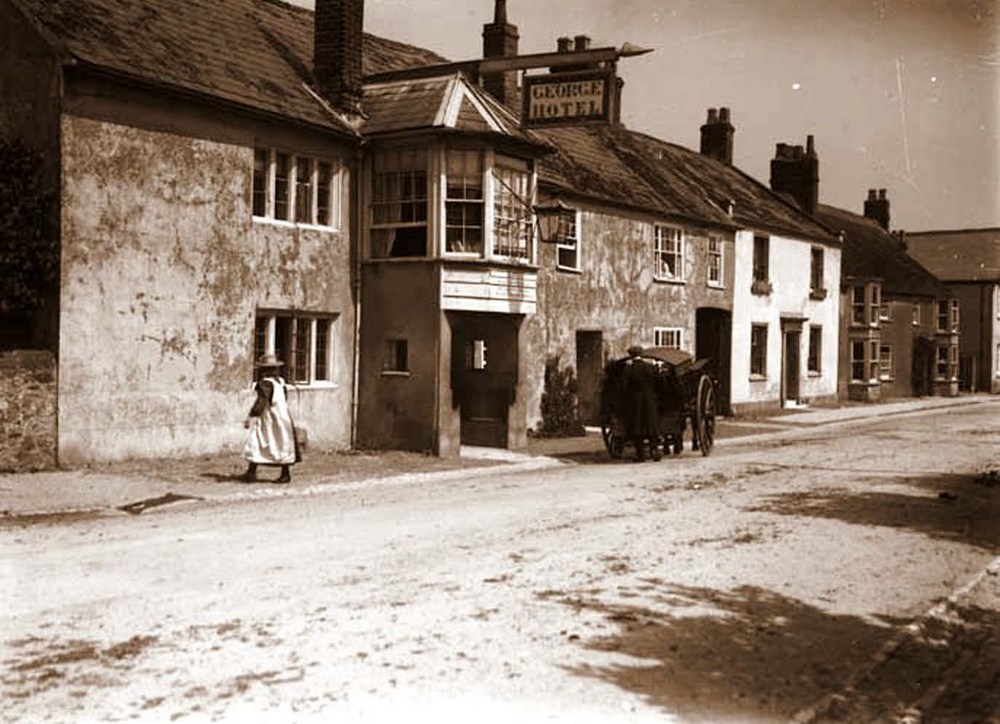
The George Inn c.1900
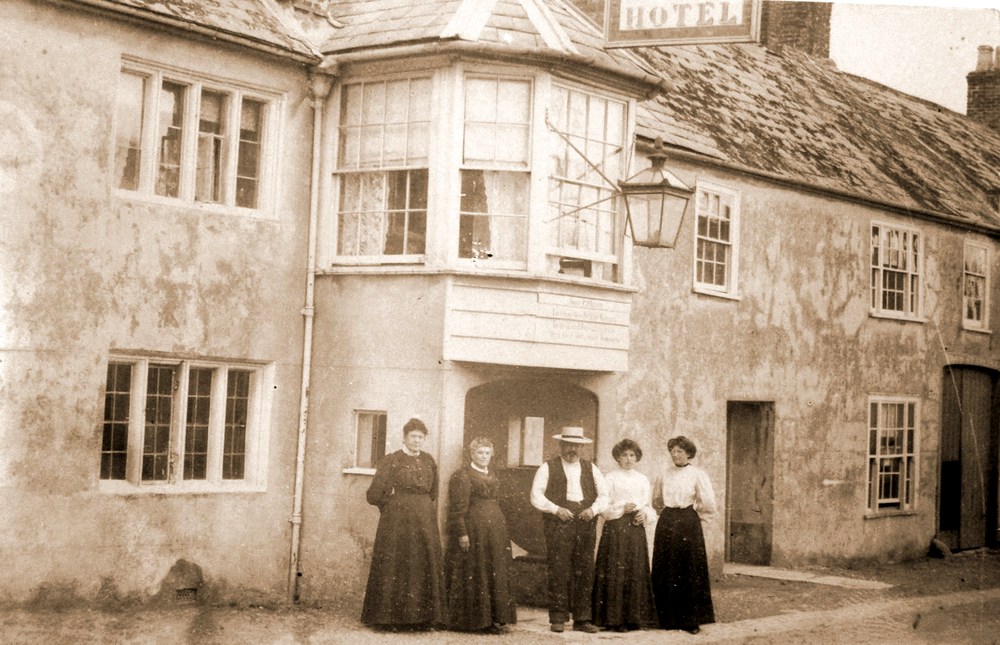
Mr and Mrs French with their daughters in 1900
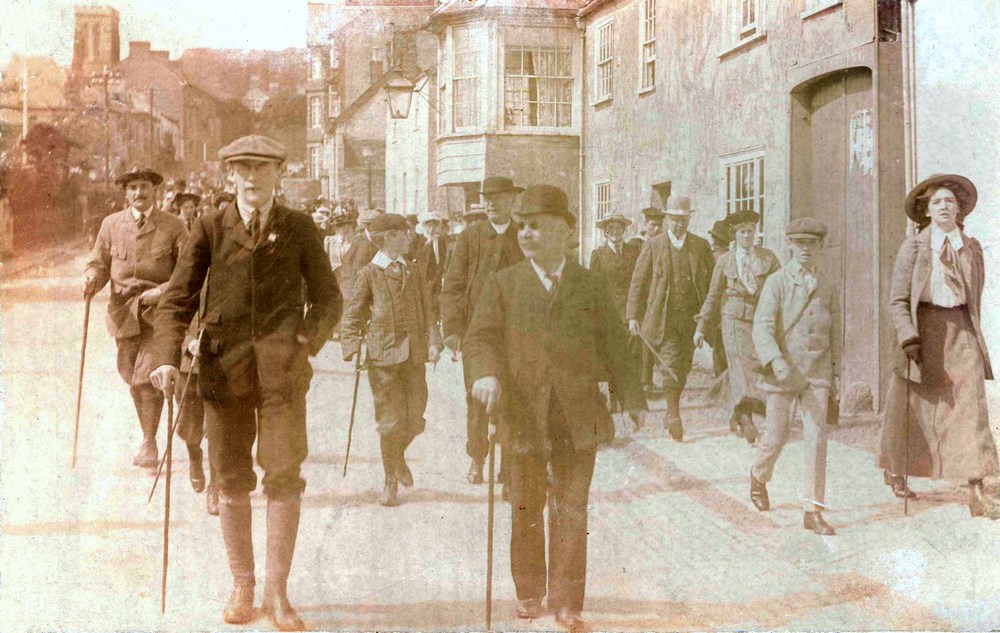
Colonel Bullen passes the George whilost he beats the annual bounds of the Village. c.1910

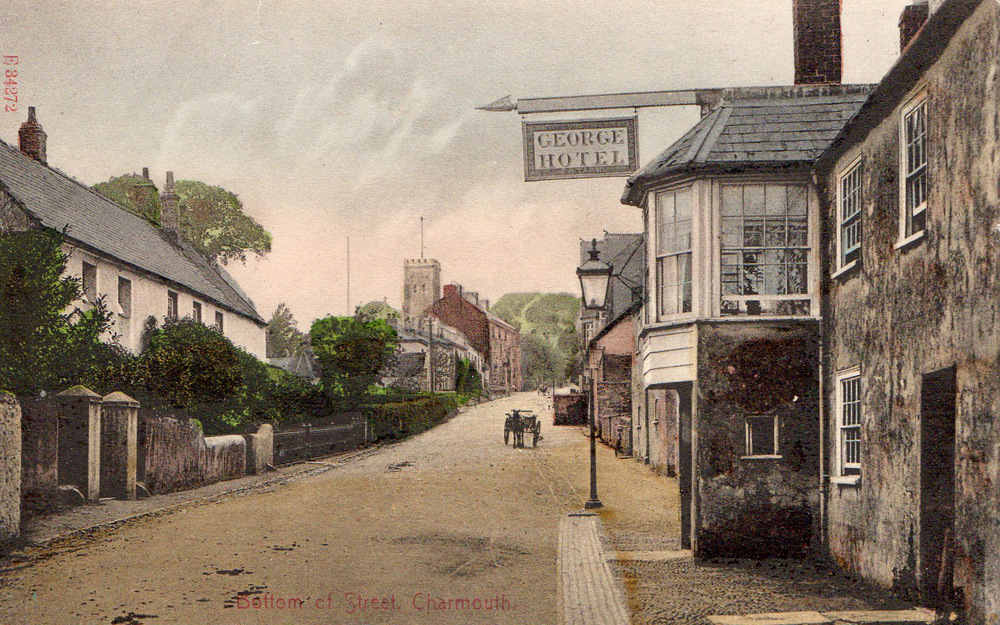

1730

John Goring the Fountain In Charmouth (Sureties-Thomas Whittle and Henry Symes of Burton Bradstock)
Hannah Newberry at the Three Crowns Charmouth (Sureties - Thomas Edwards of Charmouth Yeoman and John Diment Victualer)
John Diment of the George Charmouth (Sureties - John Newton of Stockland, Victualer and Thomas Edwards of Charmouth)
Sarah Hardy, Widow at the Ship in Charmouth (Sureties - Samuel Burrows Anthony Norman of Marshwood)
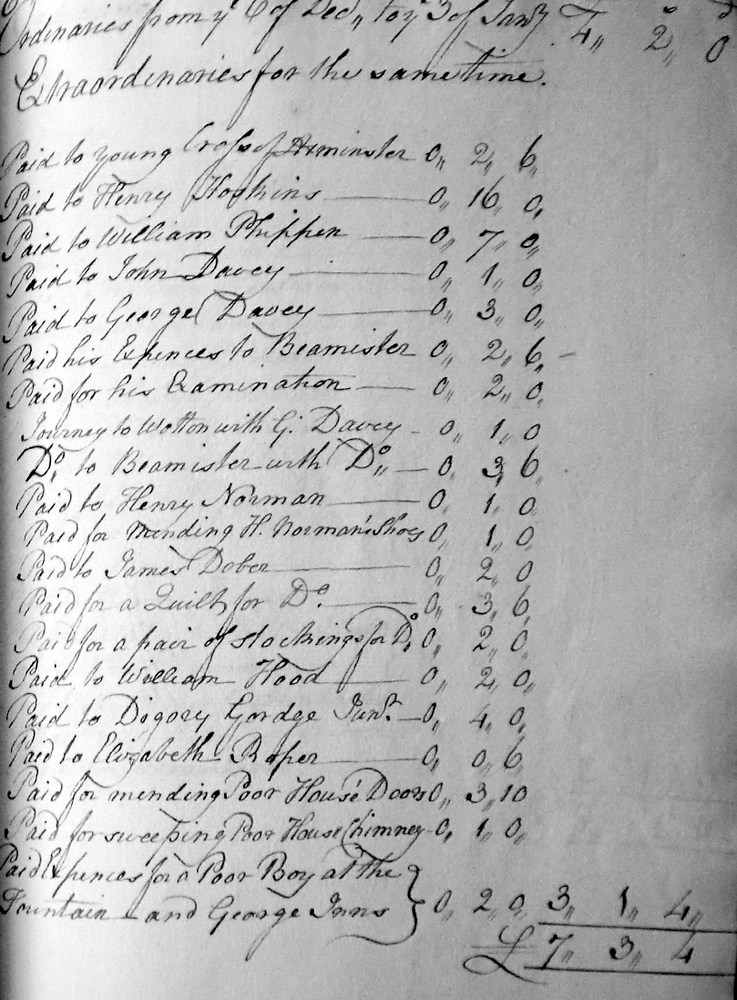
1776

Land Tax for 1795 shows Thomas Morgan paying 5/6d for The George Inn.

1799 Advert has John Diment of The George.
1807 Executors of Thomas Morgan are renting George Inn to Richard Hawkins who later purchases it

1806 Poor Rates show Thomas Morgan renting George Inn to Richard Hawkins

1806 Will of Thomas Morgan -Innholder. His daughter, Sarah is married to Richard Hawkins.

1818 Mary Hawkins married John Love (born 1797)

1823 Poor Rates show John Love renting George Inn to Robert Mills., previously Bucknol was his tenant.

1825 Poor Rates show John Love renting George Inn to Robert Mills. It includes a cottage shown in 1841 Tithe Map in Garden.
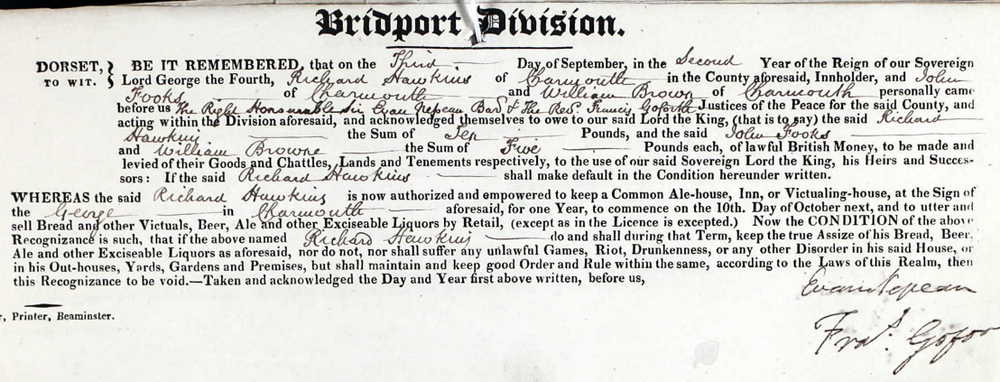
1831 License for Richard Hawkins with John Fooks of Charmouth and William Brown, acting as Surety.
The George is Auctioned by Mr. John Love in 1838
Mr and Mrs French outside the George Inn c.1900

Billy Gear oustide the George Inn in 1925 when he was renting stables at the rear for his Garage.
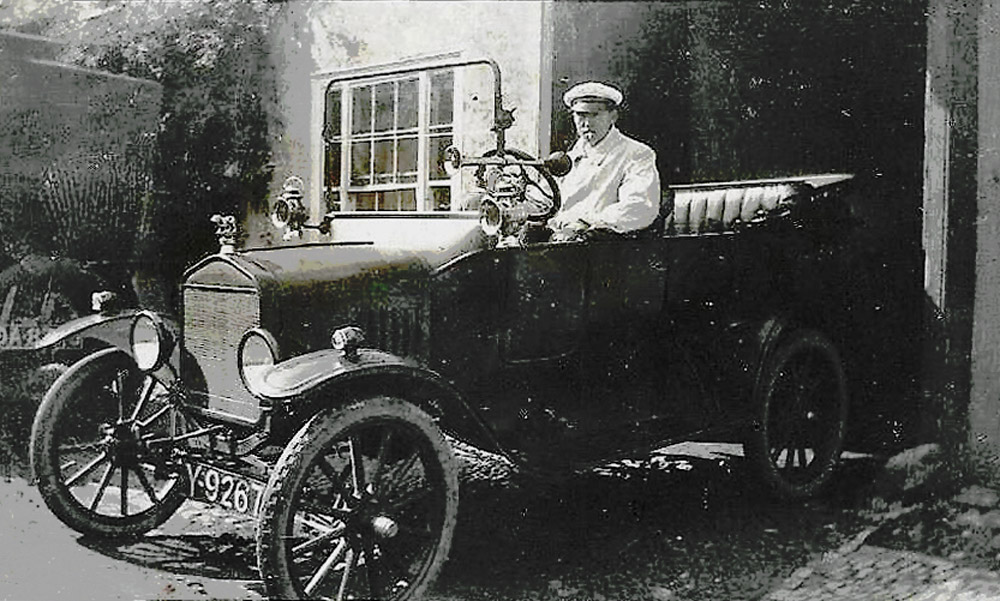
Fred White 1926 landlord of the george hotel in same car as seen above in photo of Billy Gear outside his Garage.
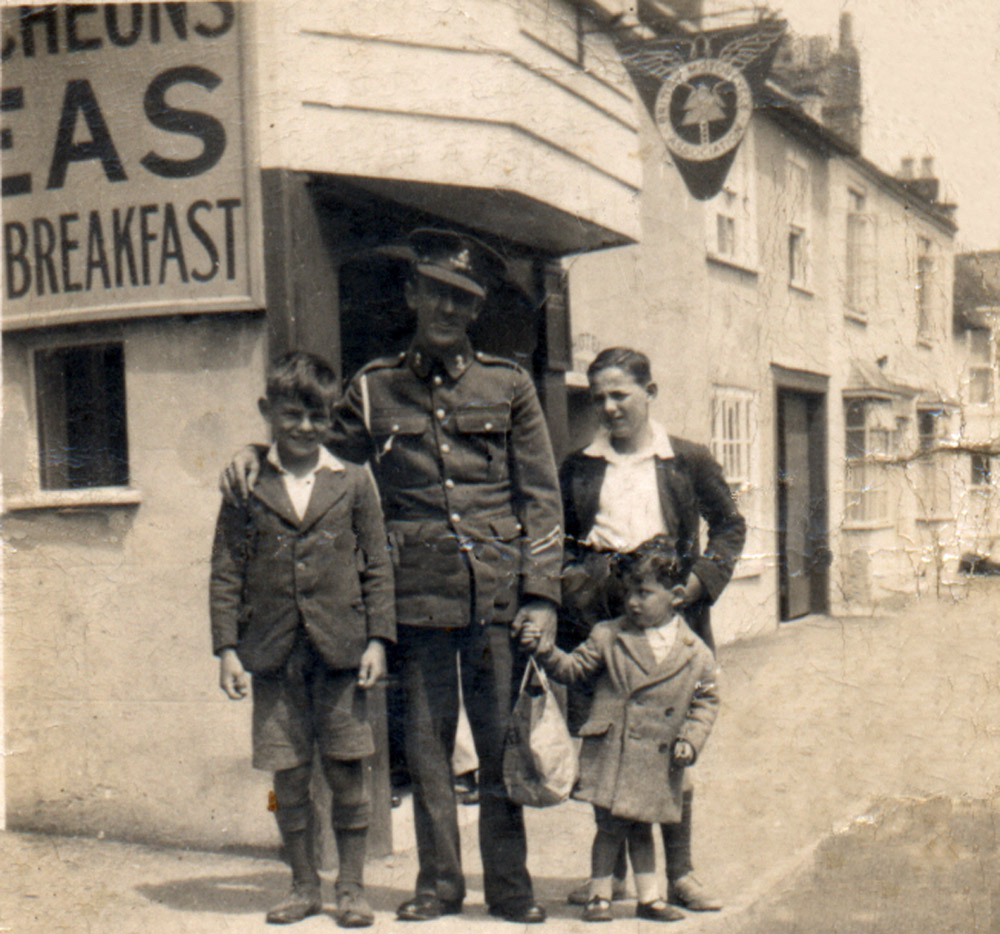
Dad John & Len Hunter & Michael outside The George.
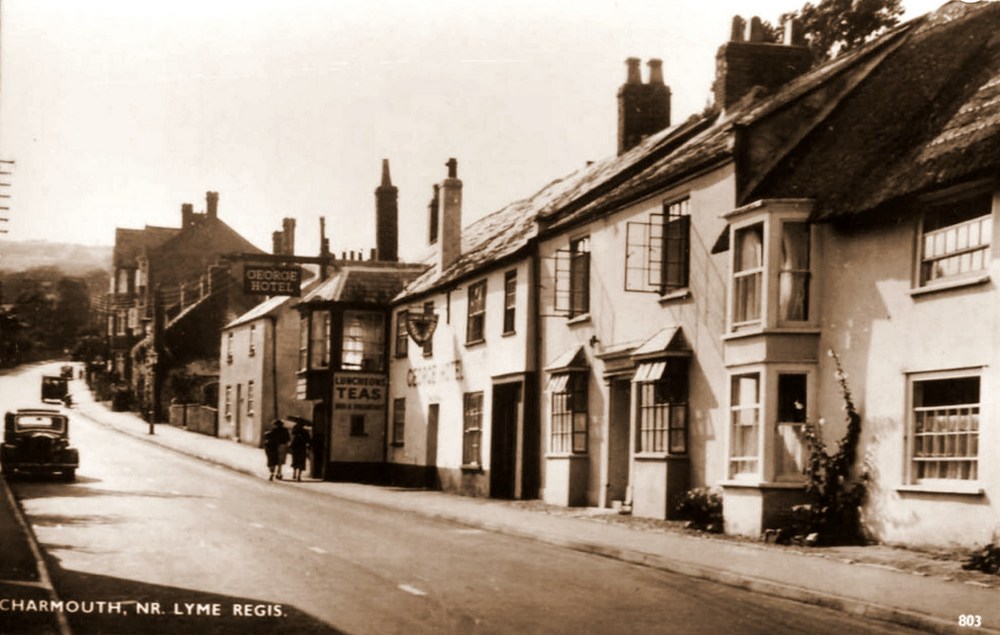
Mr and Mrs Parkin, landlords of The George stand proudly in front of their car.
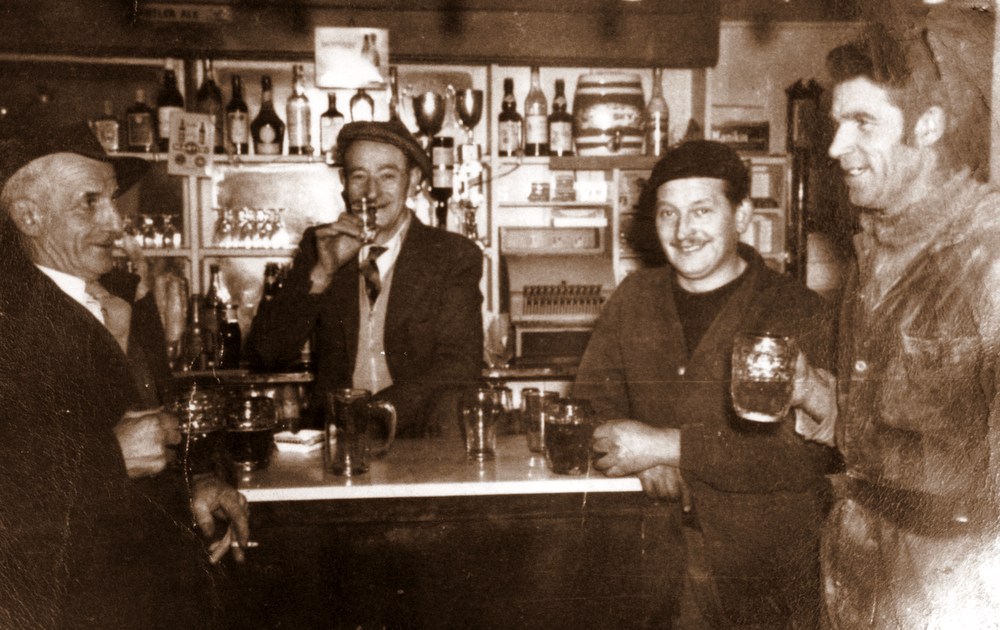








| land on which The George now stands "belonged to Forde Abbey suggests it was originally a monastic guest house | |
| 17th. century, towards the end of which the occupier was Robert Shute. He was followed by Richard Darke | |
| The Lymbrys sell to the Burridges The Fountain and probably the other 3 pubs. Mention of mabells | |
| John Burridge sells The George sold it for £60 to James Dober of Dorchester in 1704 with a 1000 year lease. James Dober of Sinsford marries Jane Sander of Dorchester in 1703 | |
| 1703 | owned by John Burridge of Lyme Regis, who leased it to James Dober, a yeoman, 'late of Stratton and now of Dorchester" . The lease was for one thousand years for which James Dober paid �60 and a rent of 'one peny at the Feast of St.Michael the Archangel, only if the same be lawfully demanded'. He also undertook to pay 2d monthly, the proportion of the poor rate of 16d monthly charged to Burridge`s lands." |
| 1723 | James Dober (George Inn) |
| 1726 | James Dober, Senior Will of 1726. Witnesses are George Browne of Bridport )Maltster and Samuel Symes - Gentleman. |
| 1743 | Samuel Burrow mortgage in 1743 into the said Walter Oke, the elder all that said tenement by payment of £200 and interest . |
| 1753 | George owned by Samuel Burrow |
| 1754 | Poor Rates list show Samuel Burow owning Parsons Estate, Watterses, Hodders and the George. |
| All that Messuage and Tenement consisting of a dwelling house, stable, Garden and Orchard containing in the whole an acre situate in Charmouth on the north side of the Street there late in the tenure of the said Robert Colbert and one Ralph Gorge as Tenants to the said John Goreing , but now in the possession of him the said Robert Colbert, who hath lately purchased it fromJohn Goreing. | |
| 1760 | Samuel Burrow sold to Walter Oke of Axmouth for £400 |
| 1761 | John Diment of the George Charmouth (Sureties - John Newton of Stockland, Victualer and Thomas Edwards of Charmouth) |
| 1763 | Walter Oke died |
| 1782 | Land Tax shows Mr Francis Oke renting to James Kendill & others |
| 1783 | His son Francis, was to inherit the properties the rentals for the village in 1783 show him as owner of the George Inn standing on an area of 2 roods, 12 perches. |
| 1783 | Frances Oke owner of George Inn 2 r 4p valued at £10 |
| 1787 | he is paying �1�3s 9d land tax and Samuel Gosling is his tenant. |
| 1795 | Frances Oke renting to Kitt and Morgan valued at 16s 3d |
| 1795 | Land Tax shows Thomas Morgan paying 5/6d for The George Inn |
| 1796 | John Diment - okes |
| 1800 | Frances Oke (Wife) died |
| 1800 | The Land Tax show that Thomas Morgan is the new owner of The George Inn�paying 5s 6d tax on it |
| 1802 | Frances Okes Lands - Thaoms Shute, John Diment - part of Okes Lands - 7s4d |
| 1805 | Okes Lands - Thomas Shute -16s 3d, Thomas Shute - part of Okes Lands -7s4d |
| 1805 | Poor Rates - Mrs Okes - Orchard -1s, 2fields and orchard 3s 9d, Field Langmoor -1s, Thaoms Shute - 7s3d |
| 1806 | Poor Rates show Thomas Morgan renting George Inn to Richard Hawkins |
| 1806 | Will of Thomas Morgan -Innholder. His daughter, Sarah is married to Richard Hawkins. |
| 1807 | Executors of Thomas Morgan are renting George Inn to Richard Hawkins who later purchases it |
| 1808 | Thomas Shute is paying tax on a house valued at 1s 5d |
| 1810 | Richard Hawkins is the landlord where he was to Stables,outhouses |
| 1814 | Thomas Shute Died |
| 1818 | Mary Hawkins married John Love (born 1797) |
| 1820 | richard hawkins - |
| 1821 | Frances Shute (wife) Died |
| 1822 | John Love buys it and Bushnole is shown as his tenant. |
| 1823 | Poor Rates show John Love renting George Inn to Robert Mills., previously Bucknol was his tenant. |
| 1823 | RobertMills is the new Landlord. |
| 1825 | Rates Book" records that John Love was owner and Robert Mills occupier |
| 1828 | John Love is shown on the Jury List as a Butcher, and Robert Mills as an Inn Keeper |
| 1831 | License for Richard Hawkins with John Fooks of Charmouth and William Brown, acting as Surety. |
| 1833 | John Love- Robert Mills- George Inn- 52 |
| 1838 | Advert in Dorset County Chronicle to be sold by Auction that Capital and well accustomed Inn r Tavern called the George Inm with messuage, a dwelling house, cottage, stables,outhouses,garden and orchard, behind the same occupied by Mr John Love. |
| 1840 | William Vallins is shown as the new owner |
| 1841 | Willima Norman rents George to William (Aged 42) and Sarah Vallins (Aged 32) 2 roods 21 perches |
| 1846 | William Vallins was among the list of Voters as Landlord, |
| 1847 | Norman & Co. was assessed for Land Tax as owners |
| 1858 | the Inn was purchased and occupied by J.D.Wheadon, a Lyme butcher. A formal opening under his management took place. |
| 1874 | The builder and Stone Mason- Harry Pryer is the new owner of the Inn |
| 1885 | James Phelps is shown as the landlord. |
| 1891 | shows him aged 49 and his wife,Merina and 4 children |
| 1895 | rates listing for 1895 show the hotel still standing on 2 acre 3 roods of land. It is still owned by the brewers Norman & co. |
| 1900 | Mr and Mrs French |
| 1915 | Sydney Rattenbury is listed in the directories as the Landlord. |
| 1954 | 1954 the front of the Inn was replastered and a mullion window, east of the porch, was discovered and which had been bricked up. |
| 1958 | O.G.White rents from Arnold and Hancock, The Brewery, Wiveliscombe. |
| They were based in Exeter and had been founded in 1845. When they were bought out by Whitbread in 1967 they had 168 tied houses. Arnold & Hancock had 262 outlets by 1955 when it was bought out by Ushers of Trowbridge. The records dating from1704 until 1944 can still be seen at the Wiltshire Record Office in Chippenham. |